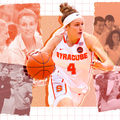House v. NCAA settlement approved, schools to now pay athletes directly

With the new House v. NCAA settlement Friday, colleges will be able to pay their athletes with a maximum of $20.5 million to split across all sports. Leonardo Eriman | Photo Editor
Get the latest Syracuse news delivered right to your inbox. Subscribe to our sports newsletter here.
Collegiate institutions have the freedom to directly pay its athletes starting on July 1 after Judge Claudia Wilken approved the House v. NCAA settlement Friday. It concludes a multi-billion dollar lawsuit that ends three antitrust cases against the NCAA and its biggest conferences. It also marks another major step in college athletics’ modern landscape dominated by name, image and likeness revenue.
For the first time since the NCAA was established in 1906, Syracuse University can pay its athletes. Every school has up to $20.5 million to share with athletes. Per Wilken’s final approval, football is expected to receive 75% of each school’s budget, followed by men’s basketball at 15%, women’s basketball at 5% and 5% for the remaining sports. The revenue share for each sector increases annually.
On Feb. 20, SU Athletics announced a sweeping $50 million fundraising plan in light of Wilken’s impending decision this summer. Wilken, the United States district judge for the Northern District of California, approved the settlement nearly two months after an April 7 hearing delayed the decision. The settlement is in effect for the next 10 years, giving Syracuse and competing schools time to build lucrative athletic programs.
Third-party NIL deals still exist, despite the settlement. However, there are more extensive restrictions to athletes signing contracts with NIL collectives, per Wilken’s decision. An NIL clearinghouse called “NIL Go” will be formed and run through Deloitte, and all third-party NIL deals of $600 or more need the clearinghouse’s approval.
According to On3, “multiple schools” are already sending over revenue-sharing contracts and deals with athletes will start getting signed as early as midnight. Wilken wrote in her decision that it hasn’t been clear whether third-party NIL deals violate any provisions. Now, there are regulations.
Roster limits will even be introduced, the new legislation said. Proposed roster limits for notable sports include 105 for football, 15 for both men’s and women’s basketball, 28 for men’s and women’s soccer and 25 for softball. This limits the number of walk-ons across collegiate sports. SU football walk-on Adam Boeheim, nephew of Jim Boeheim, previously objected to the possibility of the lawsuit moving forward.
The House v. NCAA settlement will also pay athletes who lost NIL compensation from 2016-24 a combined $2.8 billion in backpay, helping thousands of former athletes with botched NIL deals.






